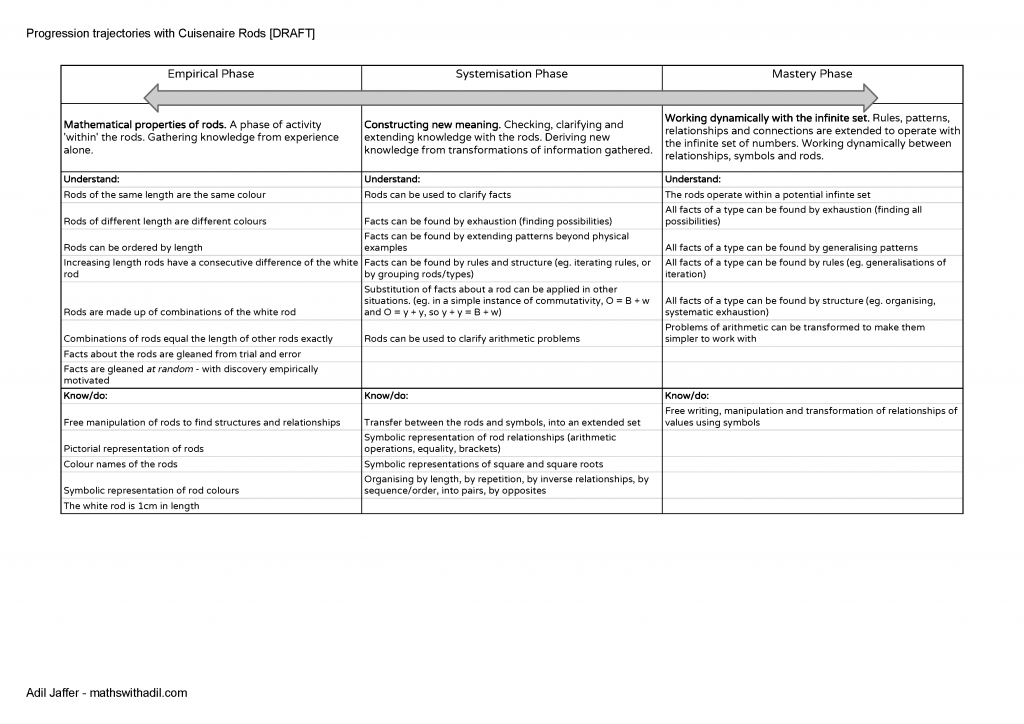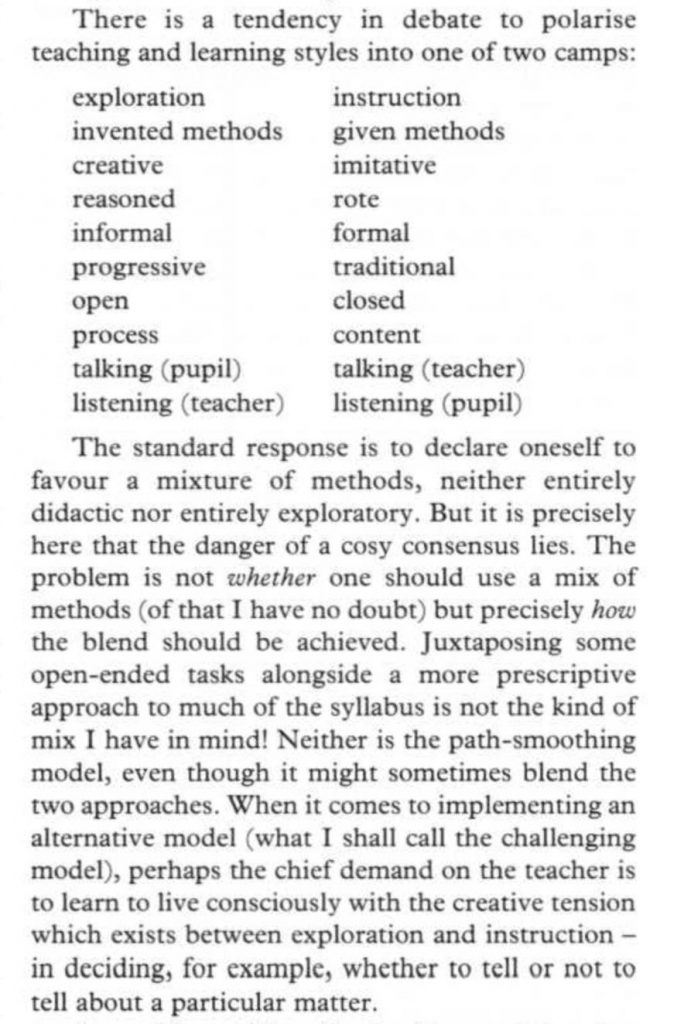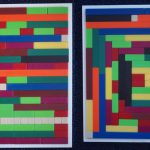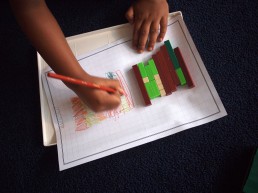Cuisenaire... what next!?
This year I am working with multiple teachers on the Gattegno method in classrooms. The conversation we often have is around what to do next after each exploration with the rods in the classroom.
We have read and understood passages from Goutard's Mathematics and Children. And, also referred to the article from Caroline Ainsworth on her research on work with Cuisenaire. To try to distil this into some sort of progression, we took the phases of working with the rods suggested by Goutard, and also referenced by Ainsworth, and then noted what we thought they looked like in terms of what children needed to understand and know.

This is our current draft. It's a live document at this moment and perhaps should remain a live/draft in the longer term. It has worked for us when making choices and listening to proposals from children about what next we can do as a class.
So for example, one class has had plenty of play with the rods and has discovered a lot of understanding from the empirical phase. However, my colleague and I wanted draw attention to fact that all rods were equivalent to combinations of other rods. Hence, our proposal last week was to make walls with the following rules for lines in the wall:
- Each line needs to be horizontal
- Lines should be unique (no repeats)
- All gaps should be filled to the exact size of the walls
This generated walls with every combination of rods for the size of the longest rod. After some lessons on this, we moved forward to explore how a rule might change the walls and activity. We added an extra rule: there should be exactly 2 rods in each line.
My colleague and I noticed that the lines were being organised in pairs of opposite combinations. For example, in the yellow wall, we would see red green and then green red on the next line.
This morning we started our lesson by talking about organising. Children felt it was good to be organised(!) and we noted some examples from home and the classroom:
- organising the pencils by colour
- organising our clothes to be ready
- organising the rods by colour
- organising the rods by length
One thing my colleague and I were keen on were to see if we could work with the children to notice that walls could be organised by length. We used the same rule as in the previous lesson, having exactly 2 rods in each line. After some exploration and then spotting how we were organising our lines we decided we needed to suggest that children build walls which organised the rods by length. As a pedagogic choice, we felt it was right to offer the proposal since it was not going to come from the children at that moment.

Feeling that this is the right thing to do is often difficult. Especially when working as a teacher and knowing that the philosophical persuasion of the schools is that of being led by children's proposals. I'm still unsure that it was the right decision! Should we have been patient and waited for the children? One thing I share with staff at my school is an excerpt from Alan Wigley's 1992 ATM article on teaching models.
Reading this gets me back to a point of trying to enjoy the tension of pedagogic choices in a moment.
With the above document to help us stay on track, we feel good too, knowing that the progression is there.
Flipping rod trays
Proposal: make patterns using the trays
Reflection students:
We were going to make some patterns. We made the two patterns in the trays. We were testing how to flip over the Minecraft (rods). We flipped over the pattern, it went into the other plate and it stayed there. We thought that the pattern would break but it didn’t.
This side is over here, but not over here (talking about the orange and blue rods on the side). When we flipped it, it went on the other side, we had no idea that would happen.
My first pattern had a line it went: green, red, green, red, green, red and the flipped one it came red, green, red, green, red, green. And on another line it was orange, white, blue and then it became blue, white, orange.
V and V
I will share this exploration with the class next week and we will explore what is happening when we flip tray patterns.
Writing
I've had some excellent conversations recently with a colleague about how we achieve the holy grail of free writing from work with Cuisenaire Rods recently. We have looked at the work done by Gattegno and Goutard and Caroline Ainsworth and are trying to figure out how we make that work for our setting.
My colleague this week introduced notebooks for her class for their discoveries with rods. The invitation is for them to keep a note of their discoveries with the rods. Not missing a trick, I decided to do the same with my class.
We first spoke about discoveries from scientists and what they do with them. We talked about our discoveries with the rods and how we should remember them. Once motivated to keep a record of their discoveries, we got to trying to note them down in new special books for discoveries.
Children were encouraged to use whatever worked for them: pictures, words or symbols. We worked on writing without access to the concrete materials; this was a suggestion from Goutard. To work on the internalised and remembered structures and not to merely describe the concrete in front of them.
Here are 3 examples:
Equivalence game
Stolen from twitter: a game of equivalences using symmetry. Each student places a train of rods and then their partner aimed to place an equivalent train on their own side. I was surprised at how challenging this was for some students.
Representing my famalam
Taking another task from the ATM Cuisenaire material, I asked the children in the class to pick 3 rods; each representing papa bear, mama bear and baby bear from Goldilocks and Three Bears. They were to hide the rods behind their backs and reveal the correct rod for each character as they came up in the story when being read aloud. This was fun. So we then thought about how to represent our own families with the rods. As well as other people outside our family.
Some good estimation and more accurate representations of the rods is happening here. I hope this leads to the children noticing that we can record our play with the rods and keep it for future.
We then listened to this song... (maybe)
https://open.spotify.com/track/6DPrhGVJ1WTZvM9fKptnGe
Representin' ain't easy
I thought I'd try out a task from the Cuisenaire booklet from ATM. It's called sandwiches and the rough proposal to children is to make sandwiches (from the rods) and then ask a friend to find the missing rod from a full sandwich. This proposal was liberally followed by children in my class today. And so was the part of noting the sandwiches made onto paper. Many definitely didn't see the 1 to 1 correspondence in size of squares on paper to the size of the rods. I found this quite surprising. Nevertheless, I think it is a worthwhile step en route to free writing with the rods.
"In the course of this free play, the child learns many things about the rods upon which, later on, he will be building his mathematical knowledge. He will discover:
1. that rods of the same colour are equal in length;
2. that those of the same length have the same colour;
3. that those with different colours have different lengths;
4. that if he wishes to make equal lengths he can only do so by putting particular rods end to end;
5. that the rods have been made so that whatever he constructs corresponds to the number of white rods."
Caleb Gattegno, Now Johnny Can do Arithmetic [1963]
Rods being used during general free play
Some children raided the rods boxes during their play activities in the classroom. I think it's some sort of ship.






























